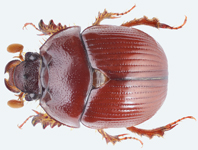Abstract
Some species of the ant genus Forelius can be misclassified as the genus Tapinoma due to the convergent reduction of the petiolar scale. I review the taxonomic status of Tapinoma antarcticum Forel 1904 and Tapinoma heyeri Forel 1902. Morphological evidence supports the transfer of these names to the ant genus Forelius. Proposed taxonomic changes are as follows: Forelius antarcticus (Forel) comb. nov. (=Forelius fazi (Santschi 1923) comb. nov., =Forelius eidmanni Goetsch 1933 comb. rev.); Forelius heyeri (Forel) comb. nov. (=Forelius heyeri risii (Forel 1912) comb. and syn. nov., =Forelius pusillus (Santschi 1922) syn. nov., =Forelius tucumanus (Kusnezov 1953) syn. nov.). Lectotypes for Forelius antarcticus and Forelius heyeri are designated. The worker of Forelius heyeri, as well as the worker and queen of Forelius antarcticus are diagnosed and redescribed. Multifocus images for lectotype workers are provided. Morphological variation within and between species of Forelius with rounded spiracles is discussed.
References
Boudinot, B.E., Probst, R.S., Brandao, C.R.F., Feitosa, R.M. & Ward, P.S. (2016) Out of the Neotropics: newly discovered relictual species sheds light on the biogeographical history of spider ants (Leptomyrmex, Dolichoderinae, Formicidae). Systematic Entomology, 41, 658–671.
https://doi.org/10.1111/syen.12181
Cuezzo, F. (2000) Revisión del género Forelius (Hymenoptera: Formicidae: Dolichoderinae). Sociobiology, 35, 197–277.
Chiotis, M., Jermiin, L.S. & Crozier, R.H. (2000) A molecular framework for the phylogeny of the ant subfamily Dolichoderinae. Molecular Phylogenetic and Evolution, 17, 108–116.
https://doi.org/10.1006/mpev.2000.0821
Evenhuis, N.L. (2020) The insect and spider collections of the world website, Bernice P. Bishop Museum, Honolulu. Available from: http://hbs.bishopmuseum.org/codens/ (accessed 23 December 2020)
Fabricius, J.C. (1793) Entomologia systematica emendata et aucta. Secundum classes, ordines, genera, species, adjectis synonimis, locis observationibus, descriptionibus. Tome. 2. Hafniae Impensis Christ. Gottl. Proft., Copenhagen, 519 pp.
https://doi.org/10.5962/bhl.title.122153
Forel, A. (1902) [Untitled. Strumigenys Lujae Forel n. sp., Tapinoma Heyeri Forel n. sp.]. In: Wasmann, E. (Ed.), Neues über die zusammengesetzten Nester und gemischten Kolonien der Ameisen [part]. Allgemeine Zeitschrift für Entomologie, 7, 293–298.
Forel, A. (1904) Miscellanea myrmécologiques. Revue Suisse de Zoologie, 12, 1–52.
Forel, A. (1912) Formicides néotropiques. Part V. 4me sous-famille Dolichoderinae Forel. Mémoires de la Société Entomologique de Belgique, 20, 33–58.
https://doi.org/10.5962/bhl.part.19251
Goetsch, W. (1933) Chilenische Wüsten-, Steppen- und Wald-Ameisen. Sitzungsberichte der Gesellschaft für Morphologie und Physiologie. München, 42, 27–35.
Guerrero, R.J. & Fernández, F. (2008) A new species of the ant genus Forelius (Formicidae: Dolichoderinae) from the dry forest of Colombia. Zootaxa, 1958 (1), 51–60.
https://doi.org/10.11646/zootaxa.1958.1.5
Kusnezov, N. (1953) Lista de las hormigas de Tucumán con descripción de dos nuevos géneros (Hymenoptera, Formicidae). Acta Zoologica Lilloana, 13, 327–339.
Menozzi, C. (1935) Fauna Chilensis. II. (Nach Sammlungen von W. Goetsch). Le formiche del Cile. Zoologische Jahrbücher. Abteilung für Systematik, Ökologie und Geographie der Tiere, 67, 319–336.
Santos-Sousa, L.M.S. (2017) Dolichoderinae (Hymenoptera: Formicidae) em uma toposequência do semiárido à pre-Amazônia. Universidade Federal do Maranhão, Centro de Ciencias Agrárias e Ambientais. Chapadinha, Maranhão, 48 pp.
Santschi, F. (1923) Solenopsis et autres fourmis néotropicales. Revue Suisse de Zoologie, 30, 245–273.
https://doi.org/10.5962/bhl.part.117787
Shattuck, S.O. (1992) Generic revision of the ant subfamily Dolichoderinae. Sociobiology, 21, 1–181.
Snelling, R.R. & Hunt, J.H. (1975) The ants of Chile (Hymenoptera: Formicidae). Revista chilena de Entomología, 9, 63–129.
Torres-Contreras, H. (2001) Antecedentes biológicos de hormigas presentes en Chile publicados en revistas científicas nacionales y extranjeras durante el siglo XX. Revista Chilena de Historia Natural, 74, 653–668.
https://doi.org/10.4067/S0716-078X2001000300011
Ward, P.S., Brady, S.G., Fisher, B.L. & Schultz, T.R. (2010) Phylogeny and biogeography of dolichoderine ants: effects of data partitioning and relict taxa on historical inference. Systematic Biology, 59, 342–362.
https://doi.org/10.1093/sysbio/syq012
Wheeler, W.M. (1934) Neotropical ants collected by Dr. Elisabeth Skwarra and others. Bulletin of the Museum of Comparative Zoology, 77, 157–240.
Wheeler, W.M. (1942) Studies of Neotropical ant-plants and their ants. Bulletin of the Museum of Comparative Zoology, 90, 1–262.


